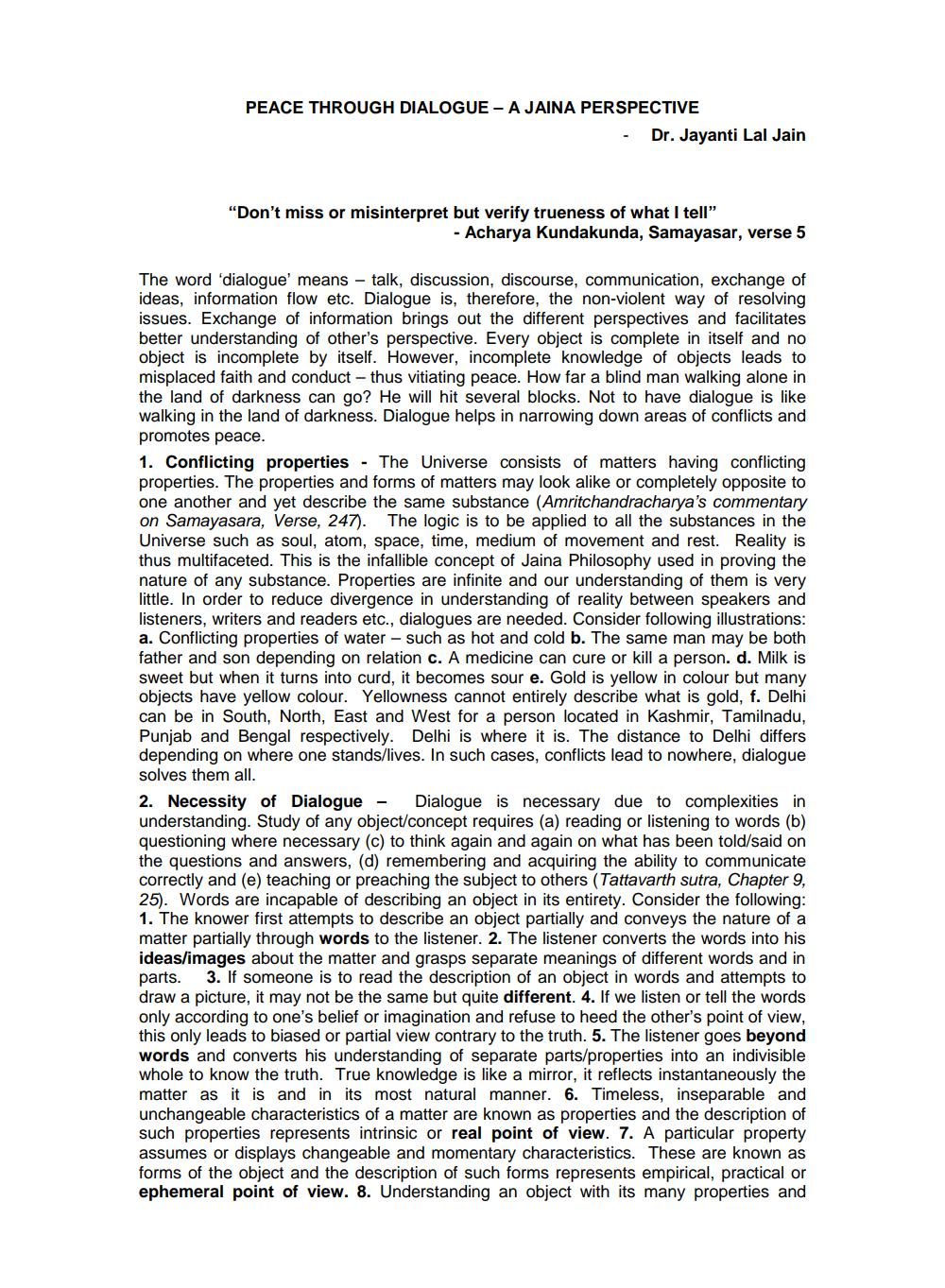Book Title: Peace Through Dialogue Jaina Prespective Author(s): Jayantilal Jain Publisher: Jayantilal Jain View full book textPage 1
________________ PEACE THROUGH DIALOGUE-A JAINA PERSPECTIVE Dr. Jayanti Lal Jain "Don't miss or misinterpret but verify trueness of what I tell" - Acharya Kundakunda, Samayasar, verse 5 The word 'dialogue' means - talk, discussion, discourse, communication, exchange of ideas, information flow etc. Dialogue is, therefore, the non-violent way of resolving issues. Exchange of information brings out the different perspectives and facilitates better understanding of other's perspective. Every object is complete in itself and no object is incomplete by itself. However, incomplete knowledge of objects leads to misplaced faith and conduct - thus vitiating peace. How far a blind man walking alone in the land of darkness can go? He will hit several blocks. Not to have dialogue is like walking in the land of darkness. Dialogue helps in narrowing down areas of conflicts and promotes peace. 1. Conflicting properties - The Universe consists of matters having conflicting properties. The properties and forms of matters may look alike or completely opposite to one another and yet describe the same substance (Amritchandracharya's commentary on Samayasara, Verse, 247). The logic is to be applied to all the substances in the Universe such as soul, atom, space, time, medium of movement and rest. Reality is thus multifaceted. This is the infallible concept of Jaina Philosophy used in proving the nature of any substance. Properties are infinite and our understanding of them is very little. In order to reduce divergence in understanding of reality between speakers and listeners, writers and readers etc., dialogues are needed. Consider following illustrations: a. Conflicting properties of water - such as hot and cold b. The same man may be both father and son depending on relation c. A medicine can cure or kill a person. d. Milk is sweet but when it turns into curd, it becomes sour e. Gold is yellow in colour but many objects have yellow colour. Yellowness cannot entirely describe what is gold, f. Delhi can be in South, North, East and West for a person located in Kashmir, Tamilnadu, Punjab and Bengal respectively. Delhi is where it is. The distance to Delhi differs depending on where one stands/lives. In such cases, conflicts lead to nowhere, dialogue solves them all. 2. Necessity of Dialogue - Dialogue is necessary due to complexities in understanding. Study of any object/concept requires (a) reading or listening to words (b) questioning where necessary (c) to think again and again on what has been told/said on the questions and answers, (d) remembering and acquiring the ability to communicate correctly and (e) teaching or preaching the subject to others (Tattavarth sutra, Chapter 9, 25). Words are incapable of describing an object in its entirety. Consider the following: 1. The knower first attempts to describe an object partially and conveys the nature of a matter partially through words to the listener. 2. The listener converts the words into his ideas/images about the matter and grasps separate meanings of different words and in parts. 3. If someone is to read the description of an object in words and attempts to draw a picture, it may not be the same but quite different. 4. If we listen or tell the words only according to one's belief or imagination and refuse to heed the other's point of view, this only leads to biased or partial view contrary to the truth. 5. The listener goes beyond words and converts his understanding of separate parts/properties into an indivisible whole to know the truth. True knowledge is like a mirror, it reflects instantaneously the matter as it is and in its most natural manner. 6. Timeless, inseparable and unchangeable characteristics of a matter are known as properties and the description of such properties represents intrinsic or real point of view. 7. A particular property assumes or displays changeable and momentary characteristics. These are known as forms of the object and the description of such forms represents empirical, practical or ephemeral point of view. 8. Understanding an object with its many properties andPage Navigation
1 2 3
